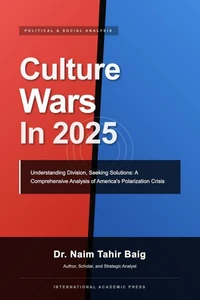Book DescriptionIn an era marked by unprecedented global military spending of $2.718 trillion in 2024 and escalating regional conflicts, the dream of a unified Islamic military alliance has resurfaced with renewed urgency. Following the September 2025 emergency summit of the Organization of Islamic Cooperation (OIC) in Doha-convened in response to alleged Israeli strikes on Qatari territory-leaders from Iran, Egypt, and Pakistan have issued fresh calls for an "Islamic NATO" to protect Muslim nations from external aggression.
NATO-like Alliance Among Muslim Nations: Possibilities and Hurdles provides the most comprehensive analysis to date of efforts to forge collective defense mechanisms among the world's 1.8 billion Muslims across 57 OIC member states. Dr. Naim Tahir Baig traces the evolution of these aspirations from the 1950 Arab Collective Security Pact through the modern Islamic Military Counter Terrorism Coalition (IMCTC)-which now encompasses 43 nations-to examine why repeated attempts at military unity have fallen short of their ambitious goals.
Drawing on primary source documents, declassified treaties, recent diplomatic communications, and extensive field research, this book dissects both the compelling strategic rationale for Islamic military cooperation and the formidable obstacles that have historically prevented its realization. With Middle Eastern defense spending led by Saudi Arabia at $80.3 billion annually and Israel's military expenditure surging to $46.5 billion in 2024, the stakes for regional security have never been higher.
The author's rigorous analysis reveals how sectarian divisions between Sunni and Shia powers, competing national interests, external dependencies on Western military technology, and the absence of shared democratic institutions have repeatedly undermined unity efforts. Yet he also identifies emerging possibilities: from bilateral defense pacts like the recent Saudi-Pakistan agreement to China's growing role as an alternative arms supplier that could reduce Western leverage over Muslim military establishments.
NATO-like Alliance Among Muslim Nations offers essential insights for policymakers, defense analysts, scholars of international relations, and anyone seeking to understand one of the most consequential geopolitical questions of our time: whether the Islamic world can overcome its internal fractures to present a unified front in an increasingly multipolar world order.
Book DescriptionIn an era marked by unprecedented global military spending of $2.718 trillion in 2024 and escalating regional conflicts, the dream of a unified Islamic military alliance has resurfaced with renewed urgency. Following the September 2025 emergency summit of the Organization of Islamic Cooperation (OIC) in Doha-convened in response to alleged Israeli strikes on Qatari territory-leaders from Iran, Egypt, and Pakistan have issued fresh calls for an "Islamic NATO" to protect Muslim nations from external aggression.
NATO-like Alliance Among Muslim Nations: Possibilities and Hurdles provides the most comprehensive analysis to date of efforts to forge collective defense mechanisms among the world's 1.8 billion Muslims across 57 OIC member states. Dr. Naim Tahir Baig traces the evolution of these aspirations from the 1950 Arab Collective Security Pact through the modern Islamic Military Counter Terrorism Coalition (IMCTC)-which now encompasses 43 nations-to examine why repeated attempts at military unity have fallen short of their ambitious goals.
Drawing on primary source documents, declassified treaties, recent diplomatic communications, and extensive field research, this book dissects both the compelling strategic rationale for Islamic military cooperation and the formidable obstacles that have historically prevented its realization. With Middle Eastern defense spending led by Saudi Arabia at $80.3 billion annually and Israel's military expenditure surging to $46.5 billion in 2024, the stakes for regional security have never been higher.
The author's rigorous analysis reveals how sectarian divisions between Sunni and Shia powers, competing national interests, external dependencies on Western military technology, and the absence of shared democratic institutions have repeatedly undermined unity efforts. Yet he also identifies emerging possibilities: from bilateral defense pacts like the recent Saudi-Pakistan agreement to China's growing role as an alternative arms supplier that could reduce Western leverage over Muslim military establishments.
NATO-like Alliance Among Muslim Nations offers essential insights for policymakers, defense analysts, scholars of international relations, and anyone seeking to understand one of the most consequential geopolitical questions of our time: whether the Islamic world can overcome its internal fractures to present a unified front in an increasingly multipolar world order.

 , qui est-ce ?
, qui est-ce ?